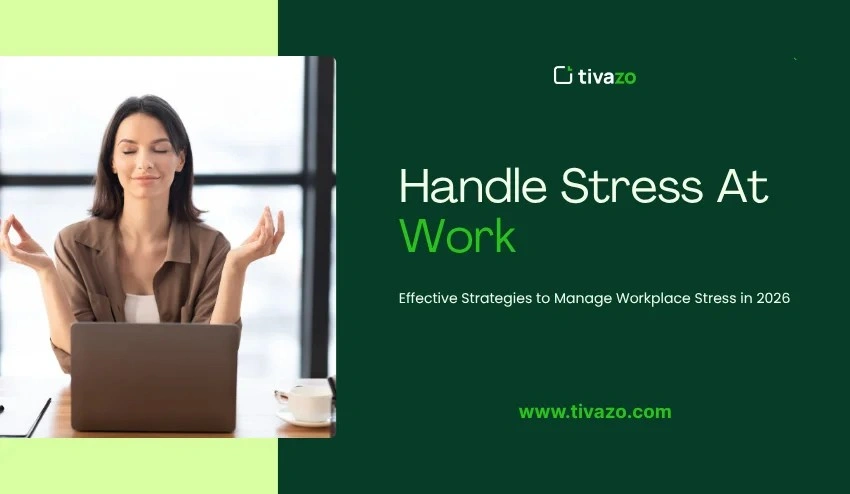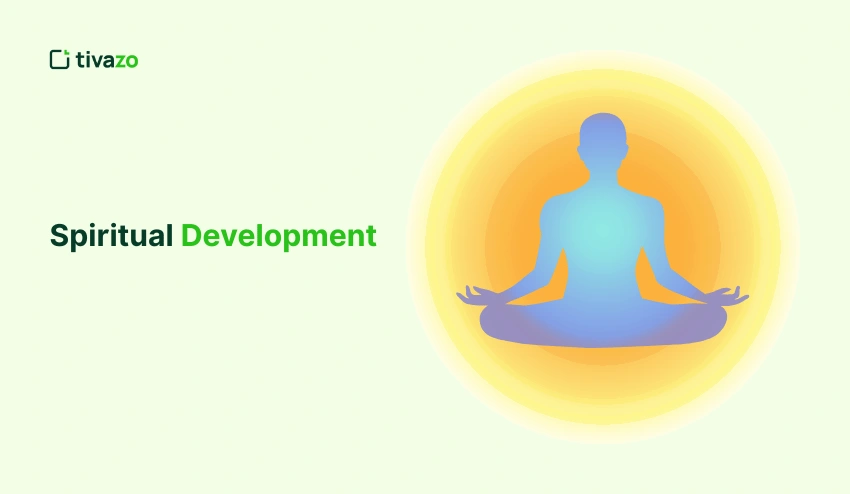For most professionals, stress within their work environment is a natural part of reality. In 2026, with the increasing demands of the digital age and changes to the workplace, understanding how to handle stress at work has become more important than for generations. Regardless of whether you’re a leader, remote worker, or entry-level employee, stress can affect your health, productivity, and happiness overall.
This blog will elaborate on 7 strategic and proven ways you can deal with stress to maintain focus, calmness, and productivity throughout the year. Let’s examine how to keep workplace stress at bay and create a more healthy work environment for you and your team.
Key Highlights:
- Strategies to Handle Stress at Work
- Handle Stress at Work from Accumulating
- Role of Physical Health in Stress Management
- Importance of Mental Health Support in the Workplace
- How Technology Can Help Handle Stress at Work
- How AI Will Help Handle Stress at Work
7 Proven Strategies to Handle Stress at Work in 2026
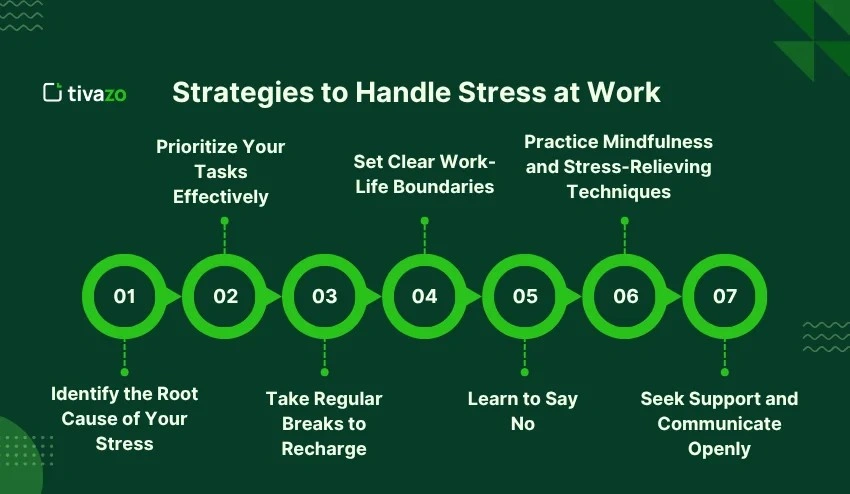
1. Identify the Root Cause of Your Stress
Stress usually occurs for a reason, whether because of a personal dispute, outside stress, or excess work. Recognizing the direct causes of the stress helps you to come up with your own personalized efforts to cope with and mitigate the stress. As you learn the source of the stress, you can direct your efforts to address and reduce it over time.
Actionable Tip: Reflect and Journal
- Start logging your work tasks to track your behaviors.
- Log the situations in which you feel your stress levels increase and use the next steps to help with formatting your responses to avoid stress.
- Pay attention to patterns and programmatic stressors, if that is the reason for feeling the stress.
- You can use the reflection to really shift your focus and change your action.
2. Prioritize Your Tasks Effectively
A messy to-do list can quickly feel burdensome, leaving you feeling all over the place without being productive. If you prioritize the task for attention and energy, you will know what your priorities are, so you can direct your time and avoid slip-ups and burnout.
Actionable Tip: Use the Eisenhower Matrix
The Eisenhower Matrix separates tasks into:
- Urgent and Important: Tasks you will do first.
- Important but Not Urgent: Schedule and do for later.
- Urgent but Not Important: Delegate and give these away if you can.
- Neither Urgent nor Important: Get rid of these and do not do.
Arranging to-do lists in this way allows you to focus on what is in your high-volume work whilst limiting distractions.
3. Take Regular Breaks to Recharge
Have you wondered how breaks help to handle stress at work? When you are continually working, you lose out on both productivity and mental health. Frequent breaks will help you restore your energy reserves, as well as build focus/creativity, and improve overall performance. By allowing yourself space to refresh you will return to work with more vigor, and this will somehow make you more productive and relieve any stress you felt before the break.
Actionable Tip: Try the Pomodoro Technique
The Pomodoro Technique is simple yet effective:
- Work for 25 minutes and take a 5-minute break.
- After 4 sessions of working and taking breaks, take a longer break of 15-30 minutes.
Short breaks prevent burnout while allowing you to return with a sense of refreshment.
4. Set Clear Work-Life Boundaries
Work-life boundaries will allow you to separate work mentally and focus on yourself outside of your job. Separating work-life in this manner means you’ll be engaged and present in both your home and work life and maintain an overall better work-life balance.
Actionable Tip: Create a Clear Work Schedule
- Set the hours that you are going to work, and keep to that schedule.
- Have a distinct workspace different from your home practice.
- At the end of the workday, avoid working on emails or tasks for work.
- Use that time for personal activities focused on relaxation.
- Having clear boundaries established will help you prevent burnout by allowing you to recharge and be present when you’re not supposed to be working.
5. Learn to Say No
Having the skill to say no is also a way to handle stress at work. Committing too much leads to a frazzled mind, inferior work, and eventual burnout. No is a skill, that teaches you to better manage your time and energy. It’s about knowing your limits and honoring them, so that you are not compromising your well-being for tasks that don’t serve the bigger aims in your life.
Actionable Tip: Practice Saying No
- Feel free to professionally refuse some tasks that do not align with your current commitments – for example, “I’m currently focused on other tasks, and I will not be able to take on any more this time.”
- Be very clear and assertive about your capacity.
- Understand how much you can reasonably manage, and do not take on more than you can reasonably manage.
- Refusal of work enables you to safeguard your time and focus on what is important to your work.
- Refusal is a healthy way to acknowledge your personal bandwidth and to remain productive and avoid burnout.
6. Practice Mindfulness and Stress-Relieving Techniques
Activities such as mindfulness or breathing techniques, specifically meditation, deep breathing or visualisation will reduce or lower the levels of stress you are experiencing, significantly. Mindfulness allows you to be in the moment and calm your state of mind regardless of the fast-paced and high stress environment. Practicing mindfulness means training your mind to remain in the moment as a way to release worry or getting distracted to a place where you’re more relaxed.
Actionable Tip: Deep Breathing & Meditation
- Try the 4-7-8 breathing technique
- Inhale through your nose for 4 seconds.
- Hold your breath for 7 seconds.
- Exhale out of your mouth for 8 seconds.
- Repeat this for 3 to 4 breaths to allow your mind and body to calm.
- This could also be incorporated into a moment of your day during your breaks for 1 to 5 minutes..
- Apps like Calm or Headspace guide you through mindfulness, meditations, or deep breathing for 5 minutes or less.
Try to incorporate mindfulness or a short meditation during your breaks. These mini practice break challenges can help condition your mind to be present and relieve stress.
7. Seek Support and Communicate Openly
Workplace stress can be lonely, but it doesn’t have to be handled alone. Honest communication can be helpful to relieve stress with anyone from your manager or HR to a trusted colleague. Discussion of stressors helps others to understand what is difficult for you, which makes it easier to develop practical ideas and emotional relief. In the work setting, your support system is just as important as your tasks.
Actionable Tip: Build Your Support Network
- Establish regular check-ins with a colleague or mentor to discuss your workload and associated stressors.
- Share any challenges you are facing with a trusted friend or coworker, who can provide another perspective or helpful advice.
- Don’t hesitate to meet with your HR department for more formal support (e.g., mental health resources) or modifications to your workload.
- Regular honest communication helps relieve feelings of isolation and allows others to support you.
How to Handle Stress at Work from Accumulating
Stress can build up quickly – especially when life feels like it is overwhelming with a massive workload or impending deadlines. It is easy to let things pile up, and neglecting stress or delaying your responsibilities may have a serious impact on both your productivity and your mental health. Preventing stress from building is important, and the most effective way to do that is to remain proactive. Breaking things down into smaller, manageable steps will make life feel less intimidating and help you feel more in control.
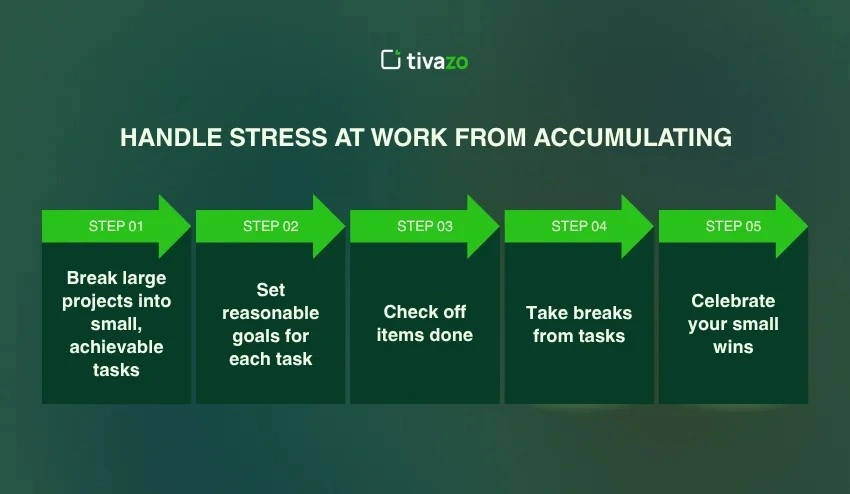
- Break large projects into small, achievable tasks: Take it one piece at a time.
- Set reasonable goals for each task: Do not let each sub-task become unmanageable in the timeframe of completing it.
- Check off items done: When you check items off, it can provide a visual representation of things you accomplished.
- Take breaks from tasks: After finishing smaller items, take a short break to reset and recharge before you begin another task.
- Celebrate your small wins: Celebrate your completed tasks as one small win. Small wins can you build momentum and motivation to keep going
The Role of Physical Health in Stress Management
Managing your body is a crucial way to manage stress at work. Your body should be taken care of through consistent physical activity, a balanced diet, and proper sleep. This has physiological effects contributing to decreased levels of stress. Exercise is helpful in particular for discharging built-up stress and stimulating endorphins for improved mood and relaxation.
Even a normal walk throughout the day or stretching your body for a few minutes can lessen stress and clear your mind. Taking care of your physical health benefits your overall health and can improve your ability to deal with stressors.
The Importance of Mental Health Support in the Workplace
Having a supportive environment that acknowledges mental health is crucial to handling stress at work. Companies that provide mental health tools, such as EAP programs, can effectively help employees handle stress at work.
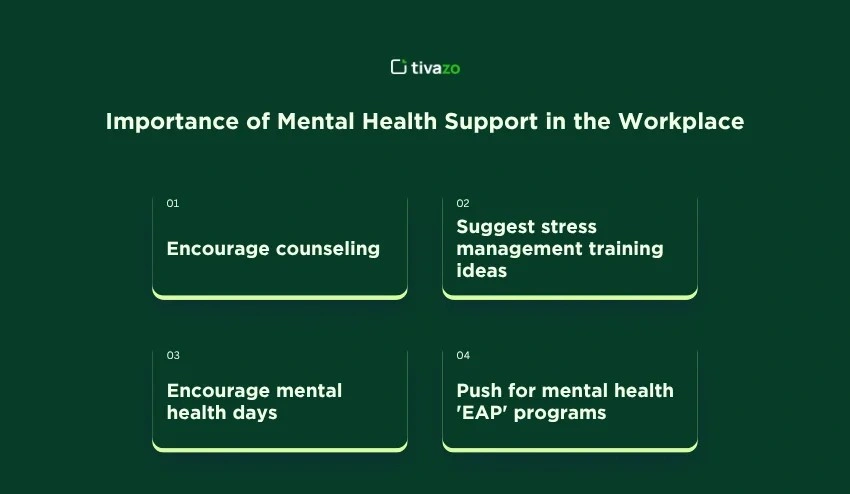
- Encourage counseling: They can promote professional help.
- Suggest stress management training ideas: They can offer ideas for training on coping skills.
- Encourage mental health days: Provide thoughts about allowing employees to have a mental health day.
- Push for mental health ‘EAP’ programs: Help integrate succession planning programs that offer aid for mental health issues.
How Technology Can Help Handle Stress at Work
In the world of 2026, technology continues to advance rapidly, and it can be an effective tool to help handle stress at work. From task management apps that help you stay organized to wellness apps that encourage mindfulness, technology can serve as a key component of a workplace support system to handle stress at work.
Apps and tools that drive productivity, health, and wellness, and time management can all help employees streamline work demands, distract themselves less, and give themselves more time to think through their work and maintain a healthier balance in terms of competing roles and responsibilities. Incorporating some of these tools and practices into your life can help you stay ahead of your work and not let it accumulate into stress.
Actionable Tip: Utilize Productivity and Well-being Apps
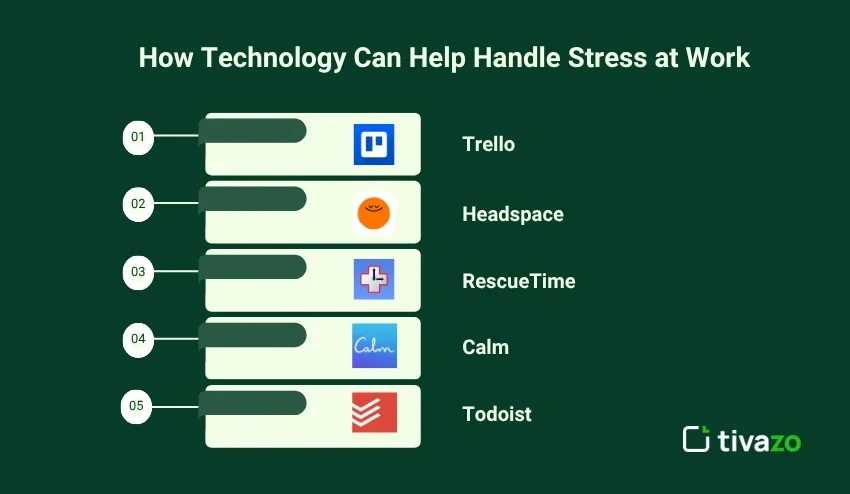
- Trello: Helps you with organizing your tasks, deadlines and visualizing your workload to keep you on track.
- Headspace: Commit to daily mindfulness/meditation sessions to handle stress at work, which will enhance your focus in the workplace.
- RescueTime: Take inventory on where you spend your time even your distractions and time management.
- Calm: Use this for guided meditation and sleep support to help continue your relaxation throughout the workday.
- Todoist: Use this for an efficient method of managing your to-do lists and breaking tasks into smaller steps, thereby, easing any intial feelings of being overwhelmed.
Incorporating some of these apps into your workflow will help you remain organized, minimize the distractions around you, and reduce overwhelming feelings related to handle stress at work.
How AI Will Help Handle Stress at Work
Artificial Intelligence has changed how we handle stress at work. It takes away repetitive work, therefore relieving workload and allows people scope to concentrate on valued and meaningful work. AI tools also streamline the monitoring of work patterns and can quantify the stress level and give individualized tips to improve psychological well-being. AI can even come from virtual assistants and wellbeing chatbots. AI will also help improve productivity and ultimately create a more balanced approach to work.
Conclusion: Take Charge of Your Stress in 2026
Managing workplace stress isn’t about not having stress; it is all about how to handle stress at work. You can do that by recognizing workplace stressors, prioritizing your work load, setting boundaries, and practicing stress techniques. You can learn to limit the negative effects of workplace stress on your employment and well-being
As we move into 2026 it is time to take charge of your mental health, introduce these suggestions into your daily routine, and do more than survive; thrive in areas of work void of stressors, and develop or demand an organizational culture focusing on psychological health and work productivity.
